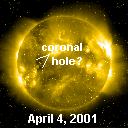|   SPACE WEATHER SPACE WEATHER
Current
Conditions
Solar Wind
velocity: 552.8 km/s
density:3.1 protons/cm3
explanation | more data
Updated: Today at 2247 UT
X-ray Solar Flares
6-hr max: M5 1725 UT Apr05
24-hr: M8 0920 UT Apr05
explanation | more data
Updated: Today at 2250 UT
Daily Sun: 05 Apr '01 
The giant sunspot 9393 has vanished over the Sun's western limb, but a new large sunspot (9415) has emerged to take its place as a potential source of solar activity. AR9415 unleashed an X1-class flare on April 3rd.
Sunspot Number: 217
More about sunspots
Updated: 04 Apr 2001
Radio Meteor Rate
24 hr max: 35 per hr
Listen to the Meteor Radar!
Updated: 05 Apr 2001 Interplanetary Mag. Field
Btotal: 6.6 nT
Bz: 3.1 nT north
explanation | more data
Updated: Today at 2247 UT Coronal Holes:

A small coronal hole is growing east of the Sun's central meridian. The many speckles in this image are caused by energetic solar particles striking the camera -- the result of an ongoing radiation storm around Earth. Image credit: SOHO Extreme UV Telescope.
More about coronal holes
 SPACE WEATHER SPACE WEATHER
NOAA
Forecasts
Solar Flares: Probabilities for a medium-sized (M-class) or a major (X-class) solar flare during the next 24/48 hours are tabulated below.
Updated at 2001 Apr 05 2200 UT
| FLARE | 24 hr | 48 hr | | CLASS M | 75 % | 75 % | | CLASS X | 20 % | 20 % |
Geomagnetic Storms: Probabilities for significant disturbances in Earth's magnetic field are given for three activity levels: active, minor storm, severe storm
Updated at 2001 Apr 05 2200 UT Mid-latitudes | 24 hr | 48 hr | | ACTIVE | 30 % | 25 % | | MINOR | 15 % | 10 % | | SEVERE | 10 % | 05 % |
High latitudes | 24 hr | 48 hr | | ACTIVE | 30 % | 25 % | | MINOR | 20 % | 15 % | | SEVERE | 15 % | 10 % |

Web server provided by
VPS Hosting
| 
Potentially Hazardous Asteroids (PHAs) are space rocks larger than approximately 100m that can come closer to Earth than 0.05 AU. None of the known PHAs are on a collision course with our planet, although astronomers are finding new ones all the time. [more]
On 5 Apr 2001 there were 299 known Potentially
Hazardous Asteroids ASTEROIDS GALORE: March was a good month for asteroid hunters. Between March 21st and 31st astronomers discovered seven Earth-approaching space rocks (click to view 3D orbits): 2001 FM129, 2001 FE90, 2001 FB90, 2001 FD58, 2001 FC58, 2001 FA58 and 2001 FO32. There is no danger of a collision with any of these asteroids. Earth-asteroid encounters (Mar 1 - Apr 30) 
- TOTAL LUNAR ECLIPSE: On Jan. 9, 2001, the full Moon glided through Earth's copper-colored shadow. [gallery]
- CHRISTMAS ECLIPSE: Sky watchers across North America enjoyed a partial solar eclipse on Christmas Day 2000 [gallery]
- LEONIDS 2000: Observers around the globe enjoyed three predicted episodes of shooting stars. [gallery]
 Feb. 21, 2001: Nature's Tiniest Space Junk -- Using an experimental radar at the Marshall Space Flight Center, scientists are monitoring tiny but hazardous meteoroids that swarm around our planet. Feb. 15, 2001: The Sun Does a Flip -- NASA scientists who monitor the Sun say our star's enormous magnetic field is reversing -- a sure sign that solar maximum is here. Jan. 25, 2001: Earth's Invisible Magnetic Tail -- NASA's IMAGE spacecraft, the first to enjoy a global view of the magnetosphere, spotted a curious plasma tail pointing from Earth toward the Sun. Jan. 4, 2001: Earth at Perihelion -- On January 4, 2001, our planet made its annual closest approach to the Sun. Dec. 29, 2000: Millennium Meteors -- North Americans will have a front-row seat for a brief but powerful meteor shower on January 3, 2001. Dec. 28, 2000: Galileo Looks for Auroras on Ganymede -- NASA's durable Galileo spacecraft flew above the solar system's largest moon this morning in search of extraterrestrial "Northern Lights" Dec. 22, 2000: Watching the Angry Sun -- Solar physicists are enjoying their best-ever look at a Solar Maximum thanks to NOAA and NASA satellites. MORE SPACE WEATHER HEADLINES |

